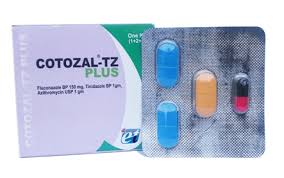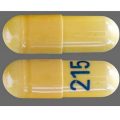What is Cotozal TZ?
Cotozal-TZ Kit is a mixed infection medication produced by Evans therapeutics, each kit contains one Fluconazole 150 mg capsule and two Tinidazole 1000 mg tablets. COTOZAL TZ PLUS is a combination of Fluconazole 150mg, Tinidazole 2g, and Azithromycin 1g in a single kit. They are both indicated for the treatment of mixed vaginal infections like viginal candidiasis, bacterial vaginosis, trichomoniasis, genital chlamydia infection, cervicitis and uncomplicated gonorrhea. It is also recommended for male partners of infected subjects to avoid re-infection. See: How to Treat Toilet Infection
Can cotozal-tz plus cause period delay?
In general, an antibiotic or antifungal medications should not delay your period. Many other issues can affect the regularity of your menstrual cycle, such as being ill or under stress or your age and related hormonal changes. However, antibiotics can sometimes interfere with your body’s mechanism, which secretes the human chorionic gonadotrophin hormone (hCG) and cause uterus shedding to delay your period. This will happen mainly because the available estrogen will be reduced to cause a change in your cycle for it to become irregular.
Can Cotozal-tz plus prevent pregnancy?
Cotozal TZ and Cotozal TZ plus are NOT birth control pills they are both indicated for the treatment of mixed vaginal infections like viginal candidiasis, bacterial vaginosis, trichomoniasis, genital chlamydia infection, cervicitis and uncomplicated gonorrhea. SEE: PostPill and Postinor 2
How Cotozal-TZ Works
Fluconazole belongs to the triazole derivative class of drugs. The agent is particularly effective against Candida species and cryptococci.
Mechanism of action: Fluconazole has a highly specific effect on cytochrome-P450-dependent fungal enzymes and is a potent and specific inhibitor of fungal sterol synthesis.
Spectrum of activity:Fluconazole has a wide spectrum of antimycotic activity. In various in-vivo animal activity studies (p.o. and i.v.), fluconazole is active in superficial and systemic infections with Candida, Cryptococcus and various dermatophytes. Candida krusei is resistant to fluconazole. The susceptibility of Candida glabrata is variable. Candida dubliniensis is not primarily resistant but shows a high tendency towards resistance, mainly during therapy. Fluconazole has little or no activity against Aspergillus, Mucor, Microsporum and Trichophyton species.
In animal experimental models of endemic mycosis, fluconazole was shown to be effective, including in infections with Blastomyces dermatitidis, Coccidioides immitis and Histoplasma capsulatum in normal and immunosuppressed animals. As with other azoles, due to the lack of a standardised procedure, the results of in-vitro tests are of lesser significance in terms of predicting clinical efficacy than the results of in-vivo studies.
Absorption: Fluconazole is well absorbed after oral intake. The absolute bioavailability is above 90%. The oral absorption is not affected by concomitant food intake. The maximum fasting plasma concentration is reached 0.5 – 1.5 hours after dose intake. 90% of the steady-state level is reached 4-5 days after dosing once daily.
Plasma concentration is proportional to the dose. After administration of 200 mg fluconazole, Cmax is around 4.6 mg/L and plasma concentrations at steady-state after 15 days are around 10 mg/L. After administration of 400 mg of fluconazole, Cmax is around 9 mg/L and plasma concentrations at steady state after 15 days are around 18 mg/L. Intake of a double dose on day 1 results in plasma concentrations of approximate 90% of steady-state on day 2.
Distribution: The volume of distribution corresponds to the total body water. The protein binding in plasma is low (11-12%). The concentration in saliva corresponds to the plasma concentration. In patients with fungal meningitis the concentration of fluconazole in the cerebrospinal fluid is approximately 80% of the corresponding plasma concentration. In stratum corneum, epidermis-dermis and in exocrine sweat higher concentrations of fluconazole are reached compared to those in serum. Fluconazole is accumulated in the stratum corneum. At a dose of 150 mg once weekly, the concentration of fluconazole in stratum corneum was after 2 doses 23.4 µg/g and seven days after the second dosing it was still 7.1 µg/g.
Elimination: Fluconazole is mainly renally excreted. Approximately 80% of the administered dose is excreted in the urine in non-metabolized form. Fluconazole clearance is proportional to the creatinine clearance. Circulating metabolites have not been demonstrated. The half-life in plasma is approximately 30 hours.
Indications
Acute or recurrent vaginal candidiasis when systemic therapy is considered appropriate.
Mucosal candidal infection.
These include oropharyngeal, oesophageal, mucocutaneous and non-invasive bronchopulmonary candidiasis and candiduria, in patients with compromised immune function.
Systemic candidiasis in non-neutropenic patients.
Acute cryptococcal meningitis in adults. Fluconazole can be used as maintenance therapy to prevent relapse of cryptococcal disease in patients with AIDS. Prophylaxis of deep-seated candida infections (particularly Candida albicans) in patients with neutropenia due to bone marrow transplantation. Consideration should be given to official guidance on the appropriate use of antifungal agents.
How to take Cotozal tz
Cotozal-TZ kit is a single-dose therapy and should preferably be given to both partners to minimise recurrences. Tell your doctor if your condition does not improve after 3 days or lasts more than 7 days. Tell your doctor if your infection returns within 2 months. You may need a different or additional medication to treat your condition.
Contra-indications
It is contraindicated for use in patients hypersensitive to fluconazole or any other ingredient in the fluconazole capsules. Patients taking terfenadine or astemizole (antihistamines), cisapride. Patients with heart disease including heart rhythm problems and patients with low blood level potassium and /or calcium. Cotozal–TZ is contraindicated in those patients with blood dyscrasias; in pregnancy and lactation.
Precautions/Warnings
In some patients, particularly those with serious underlying diseases such as AIDS and cancer, abnormalities in haematological, hepatic, renal and other biochemical function test results have been observed during treatment with fluconazole but the clinical significance and relationship to treatment is uncertain.Very rarely, patients who died with severe underlying disease and who had received multiple doses of fluconazole had post-mortem findings, which included hepatic necrosis. These patients were receiving multiple concomitant medications, some known to be potentially hepatotoxic, and/or had underlying diseases, which could have caused the hepatic necrosis.
In cases of hepatotoxicity, no obvious relationship to total daily dose of fluconazole, duration of therapy, sex or age of the patient has been observed; the abnormalities have usually been reversible on discontinuation of Fluconazole therapy. As a causal relationship with fluconazole cannot be excluded, patients who develop abnormal liver function tests during fluconazole therapy should be monitored for the development of more serious hepatic injury. Fluconazole should be discontinued if clinical signs or symptoms consistent with liver disease develop during treatment with fluconazole.
Patients have rarely developed exfoliative cutaneous reactions, such as Stevens – Johnson syndrome and toxic epidermal necrolysis, during treatment with fluconazole. AIDS patients are more prone to the development of severe cutaneous reactions to many drugs. If a rash develops in a patient treated for a superficial fungal infection, which is considered attributable to fluconazole, further therapy with this agent should be discontinued. If patients with invasive/systemic fungal infections develop rashes, they should be monitored closely and fluconazole discontinued if bullous lesions or erythema multiforme develop.
In rare cases, as with other azoles, anaphylaxis has been reported. Some azoles, including fluconazole, have been associated with prolongation of the QT interval on the electrocardiogram. During post-marketing surveillance, there have been very rare cases of QT prolongation and torsade de pointes in patients taking fluconazole. Although the association of fluconazole and QT-prolongation has not been fully established, fluconazole should be used with caution in patients with potentially proarrhythmic conditions.







